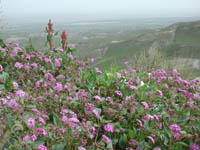Mojave sand-verbena facts for kids
Quick facts for kids Mojave sand-verbena |
|
|---|---|
 |
|
| Scientific classification |
Abronia pogonantha is a cool flowering plant often called the Mojave sand-verbena. It belongs to the four o'clock family, which is a group of plants known for their colorful flowers that sometimes open in the late afternoon. You can find this plant growing naturally in parts of California and Nevada. It especially likes the sandy areas of the Mojave Desert, nearby hills, and even some parts of the San Joaquin Valley in the bigger Central Valley.
What is the Mojave Sand-Verbena?
The Mojave sand-verbena is an annual herb. This means it grows from a seed, flowers, makes new seeds, and then dies, all within one year. It usually grows low to the ground, spreading out, but sometimes its stems can stand up. These stems can reach about half a meter (about 20 inches) long. They also feel a bit sticky because they have tiny glands on them.
Leaves and Flowers
The leaves of the Mojave sand-verbena are mostly oval-shaped. They have a stem, called a petiole, that connects them to the main plant stem. Each leaf can grow up to 5 centimeters (about 2 inches) long and 3 centimeters (about 1.2 inches) wide.
When the plant blooms, it produces many flowers grouped together. This group of flowers is called an inflorescence. The flowers are usually white or pink. Each flower has a long, tube-like part that can be up to 2 centimeters (about 0.8 inches) long.
Fruit and Seeds
After the flowers bloom, the plant makes a special kind of fruit. This fruit is shaped like a heart and has small wings on it. It's only about half a centimeter (about 0.2 inches) long. Inside this fruit are the seeds, which will grow into new Mojave sand-verbena plants next year.

